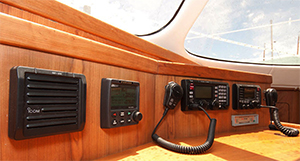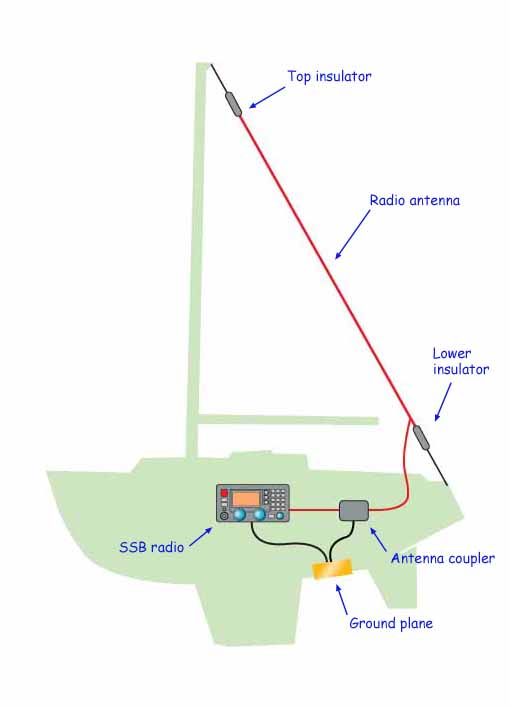What is an SSB and Do I Need One?
May 6th, 2021 by team

by B.J. Porter (Contributing Editor)
If you’re buying a boat, you may come across an item on the inventory that says something like this:
Icom IC-M802 SSB Radio w/ AT-140 Tuner
So we know it’s a radio, but what does the SSB mean?
“SSB” is short for Single SideBand radio, also known as a High Frequency (HF) radio, or in old maritime thrillers as a “shortwave.” It’s a radio which broadcasts and receives on a much wider and lower range of frequencies than your VHF radio.

Do You Need One?
Without getting into the gruesome technical detail…the answer for most boaters is: Probably Not.
If you are planning to cruise full time or sail offshore making blue water passages, then an SSB can be a VERY useful and powerful tool. But if you’re a casual coastal sailor, you will have little use for one.
Marine SSB can send voice and data over long ranges, sometimes several thousand miles if atmospheric conditions are favorable. Most weekend boaters don’t need to talk to people that far away as part of their regular boating activities.
The Case FOR Getting an SSB
If you plan to cruise the world or cross oceans, there is an excellent case to be made for having an SSB.
While some claim that a satellite phone is a suitable replacement for emergency and rescues, there are many disadvantages when compared to an SSB.
- An SSB DSC distress call will activate the Global Maritime Distress and Safety System (GMDSS) to your troubles when it is received. You can do this with a phone call too, but it’s not automatic.
- Your SSB Distress call is broadcast to every ship in range, and range can be hundreds or thousands of miles. A satellite call goes to one number.
- The distress call is broadcast to ships closer to your vessel; far off shore your most likely rescue is from nearby marine traffic.
- Commercial ships are required to monitor GMDSS frequencies, so any ship nearby can pick up your call.
- Rescue vessels without satphone capability can reach you to coordinate a response via radio.
And of course, there are the social aspects. For a fleet of small vessels cruising near each other but spread out over hundreds of miles of water, it’s the best way to keep in touch.
Crossing the Pacific, we had half a dozen other boats between the Galapagos and the Marquesas at the same time. We kept up a daily net, where we’d meet on the air and share our positions, help each other with problems, brag about the fish we caught, and give each other general updates. We knew who was out there, where they were, and if someone didn’t check in, there were other people nearby to help. While it helped pass the time and made being alone at sea less lonely, it also gave us a very important safety net.

How is SSB Different From a Marine VHF?
There are several key differences in operation and capabilities between the two.
The Short Answer
SSB uses different, lower frequencies and has a much longer range.
Also, it’s not set up in neat numbered channels like a VHF so it’s trickier to use. And much more expensive and complicated to install.
The Longer, More Technical Answer
Marine VHF (Very High Frequency) is the standard radio we use to call boats in within a few miles of us. VHF is limited to line-of-sight distances, and it’s rare to speak with people over ten or fifteen miles away at all, never mind clearly. Sailboats with masthead antennas and fixed VHF radios can do it, since line-of-sight increases from the top of the mast, but even that is limited to twenty-five or so.
VHF Frequencies range from 30 to 300 Mhz and have wavelengths from three feet to about thirty-five feet (1 meter to 10 meters). These short wavelengths don’t travel that far and don’t penetrate things, and are absorbed by the ionosphere.
Single Side Band uses High Frequency (HF) from 3 to 30 Mhz, with wavelengths of 10 to 100 meters (30 to 330 feet). These longer wavelength, low frequency signals will bounce off things, including the upper atmosphere. This bounce allows the radio waves to travel very long distances. HF radio waves can propagate all the way around the world, though ranges of a few hundred to a couple of thousand miles are more typical.
A marine SSB, like an Amateur Radio, will allow operation on exact frequencies. Marine VHF has set “channels” which are agreed upon frequencies for standard marine operation in a country. When you call on Channel 16 on VHF, your radio is tuning in to the 156.800 Mhz frequency behind the scenes, which other radios expect and you don’t need to worry about. These frequency-to-channel assignments are federally regulated and consistent, which is why they work are easy to use.
A marine SSB may come with “channels,” but they are a more loosely agreed upon names for frequencies. There’s no governing body to say “This is Channel 55” so everyone agrees. It makes finding a frequency to chat on a little more challenging.
The installation is also more complex, and costs are higher. A VHF radio needs a power supply and an antenna. An SSB needs these as well, but also it needs a “ground plane,” an antenna tuner (sold separately!), and possibly a second antenna. The primary antenna can be large, and many use an insulated section of the backstay. This works well, but requires cutting the backstay and installing insulators. The cost and complexity are discouraging unless you really need or want it.
If I have an SSB Already, What Can I do with it?
If you have a functioning SSB on your boat and you plan to cruise offshore, learn how to use it. It’s a powerful tool for staying in touch with other cruisers, and for getting help if you need it.
Even if you’re not cruising, if you have one take some time to learn how to use it, you can have some fun with it. But you might find the effort to do more advanced functions (like getting weather faxes) not worth it if you’re in cell phone range and can download the same information on your phone in seconds.
A few things you can do include:
- Learn how to contact far off stations. Getting an Amateur Radio license (also called a Ham License) is a good way to learn. With a Ham license, you can talk to many more people in other countries.
- Learn to do digital communications. It’s slow, but you can get and send e-mail when you don’t have a connection to land.
- Get weather faxes and weather information.
- Send distress calls over much longer distances than VHF.
- Posted in Blog, Boating Tips, Cruising, iNavX, iNavX: How To, Navigation, Sailing, Sailing Tips
- 6 Comments


December 24, 2022 at 2:39 am, Robert Moore said:
the SSB radio system is a significant advancement in the world of radio communication allowed sailors to navigate and effectively interact.
December 26, 2022 at 10:32 am, Robert Moore said:
The transceiver, which is usually hidden behind the covers, includes all the key electronics, PCBs, and crucial elements for reception and transmission.
July 22, 2023 at 9:23 am, Tom Brian said:
This kind of radio is frequently used on yachts and boats. You may therefore hear people refer to it as a marine single sideband radio. Access to essential marine radio channels is provided along with two-way communication on board.
August 17, 2023 at 4:20 pm, Steve Lee said:
Definitely a critical tool for any sailors planning extended cruising…we used to use these in the Keys back in the day on all our boats…thanks for breaking down the intricacies of SSB!
February 25, 2024 at 6:00 pm, Drake Geco said:
Thanks for the explanation about what Is an SSB radio and how it works and how one can have fun with it even if not sailing.
May 08, 2024 at 11:44 pm, Joe Mullins said:
Do you need a license to operate a single side band radio ?